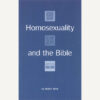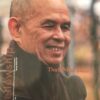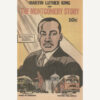by Rev. David Billings
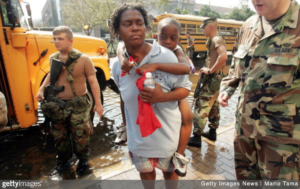
It seems like yesterday: Images of New Orleanians on rooftops crying out for someone to rescue them; sleeping in the Superdome crying out for police protection; stranded on the interstate on foot with no car; standing in line at the convention center waiting on buses that never came; homeless at the Greyhound Station with no food or water.
This was the shocking aftermath of Hurricane Katrina in 2005: Some people living in trees while others sought escape across the Mississippi Bridge, only to be met by police blockades barring their passage. Police in full military garb, armed with machine guns and on high alert protecting the people from the people. Or let me tell the truth: protecting white people and white property from an “invasion” by Black people with no property. At least in these realities you were home.
You could look from the interstate and see your neighborhood, or while in line at the convention center you could envision turning around and walking back to what used to be your home. But the worst for some was yet to come. If you were from New Orleans and had never left the city, you didn’t even fathom that you might be transported by the government to St. George, Utah, where no Black people lived, or to San Antonio, Texas, where few did, or New York City, where so many people lived that you would be “sheltered in place” in huge hotels next to the airport for the next year. Many would not see their family for a future that seemed interminable. Some would die alone, never to see family again.
The comparisons with 2020 are inescapable if you’re from New Orleans and if you’re Black or poor. It was said then — and it is said now — that Mother Nature does not discriminate. She sees no color. She is an equal opportunity destroyer. That is, unless you are Black or Brown in a nation that always sees color. You know Mother Nature sees color. She sees you. Name it Katrina or COVID-19, there is no doubt she sees you and knows where you live.
Fifteen years ago, I wrote about what would happen to New Orleans after Katrina. It seemed like there were two likely scenarios. Both were informed conjectures. I knew something about economics on the ground level and a bit more about race and structural white supremacy.
The first scenario was to transform New Orleans into a designated travel destination where people (largely white people) would be lured into town by good food, good (if slightly raunchy) times and for the vibrant jazz and music scene. To boot, once you were partied out, you could get up and take the streetcar through the Garden District and see the grand mansions along St. Charles Avenue. These mansions would evoke antebellum nostalgia bordered on one end by the statue of Robert E. Lee, which was removed this spring, and Camellia Grill on the other — with some of the best food you ever tasted. To the average tourist, New Orleans was a predominately white city, fun-loving and care-free. And the police were everywhere — to protect and to serve, just in case.
This was the plan and even with all its problems stemming from its oppressive racial caste system, it was doing pretty well post Katrina. It was a short-lived strategy and, as it turned out, a temporary solution before COVID-19 hit town and the economy busted up the tourist trade. Restaurants were boarded up and many will never open again. Musicians haven’t had work in months; the Jazz Festival has been postponed for the foreseeable future. And the death rate from the virus is one of the nation’s highest on a per capita basis. Per capita, by the way, means little to you if you’re dead, or to the family and friends who mourn your loss.
What about reparations, the second scenario? What might have been the outcome if Black New Orleans had been invested in, really for the first time? What if an economy — built largely by Black folks, minimum wage earners of any race, and the natural resources via the Mississippi River — had been used to make reparations for the crimes against its Black residents, for the generations of Africans enslaved since the first ships disembarked with their ancestors? What about repairing the loss to New Orleans school children and their families for the damage done when 7,000 school teachers were fired after the teachers’ union was decertified and outlawed by the post-Katrina Louisiana legislature? This was a crime that affects all New Orleanians 15 years after Katrina.
Reparations need not be seen as punishment for white folks, but as a long overdue investment in the nation’s future. The murder of George Floyd by police in Minneapolis was no aberration. Such actions on the part of police authorities have been going on since the founding of the republic. Hidden behind the mask of racial capitalism, police protection has enriched a precious few in this society, but it has convinced most white people that our quality of life is dependent upon maintaining an obscenely oppressive culture of racial dominance.
If the duties of police departments were subject to a race equity lens, it would be found that most calls to the police begin with calls to 911. These calls are usually not concerned with threats to life or even property, and can be better handled through civilian administrative procedures and by better trained and empathetic community residents or workers. The savings would be in the millions of dollars for every big city and small town in America.
The model exists with volunteer fire departments and suicide prevention hotlines. Money could then be reinvested in community infrastructure, free college tuition and legal services to the poor. It is possible to take the profit motive out of monitoring and policing the lives of Black and Brown people. This is a type of reparations that could also provide monetary resources to every Black and Brown family/person in the country.
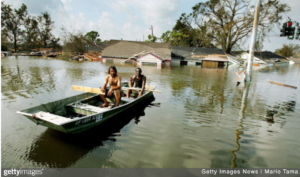
Had such preventive policies been envisioned for New Orleans and put in place prior to the storm, the environmental loss and human suffering would have been infinitesimally reduced. Black people’s loss of life and home would have still been tragic, but sufficient resources would have been available to help people rebuild. Instead, business and political elites relocated poor and Black people — preventing tens of thousands from returning. Then they handed over the city’s systems of education, health care, housing and business initiatives to outside private, profit-driven entities.
In New Orleans during Katrina — and throughout the U.S. today — structural racism is what holds us hostage. Black lives have never mattered. Murder convictions for white people killing Black people have been rare; indeed, for the first 300 years or so (1619 to about 1959), such convictions were adjudicated as property crimes. When Morris Dees and the Southern Poverty Law Center won a 1987 conviction in the lynching of Michael Donald against the United Klans of America in Mobile, Alabama, no one was jailed or imprisoned; instead, the Law Center was awarded the Klan-owned building. Black people were more valued as property than as human beings.
Police killings, extra-judicial as well as those committed under the guise of structural authority, have always occurred. I know of no in-depth study that attempts to enumerate just how many. We know 646,000 died during the Civil War, but not how many Black people have died at the hands of the police throughout the nation’s history.
Black rage against the police is utterly understandable, even if violence against the police by Black people scares the hell out of white people because they fear it will lead to insurrection if not immediate repression. The unarmed nature of so many of the murders is stunning; so often they are for non-threatening offenses like walking down the middle of the street, like Michael Brown in Ferguson, or selling individual cigarettes outside a convenience store in Staten Island, like Eric Garner. Ahmaud Aubrey in Brunswick, Georgia was murdered by neighborhood vigilantes again for perceived property violations. The list goes on. Breonna Taylor in Louisville, Kentucky killed in her house. For what? I forget what George Floyd was supposed to have done.
There are models of how police really do “protect and serve” neighborhoods. They are called white communities. Not just upper income white communities. I have lived in white working-class areas a good part of my life. I can’t conceive of an unarmed white man being shot in the back by police while running down the street, or a white woman having her door broken down and killed inside her home with a mob of Black people on her porch. It strains the bounds of credulity.
We have seen the clips on TV. We have heard the stories. We can make the requisite excuses. We can say race had nothing to do with it. There is nothing that happens in the United States where race does not factor into it. Somehow, it always does.
There are Black citizens of New Orleans who never returned after Katrina. Some chose not to go back. New Orleans is not a perfect place. Too much violence. Too much poverty. Too few jobs that pay a living wage. Disney on the Bayou has not worked. The Big Easy is hard. But it is still one of America’s great cities. One of the only places, I think, where the Rev. William H. Barnwell, a white civil rights leader who died of the coronavirus, can be spontaneously honored with a second line parade dancing in front of his house by a crowd of mostly Black folks.
If there are situations that only armed police can handle then spell them out and let them do their job, closely watched and held accountable by those parts of the public most impacted by police violence. The same goes for epidemics. Let’s have emergency response centers, fully equipped and ready to go when the first signs of true invasions are known. Lives depend on it. All lives depend on it. Some lives more than others.



